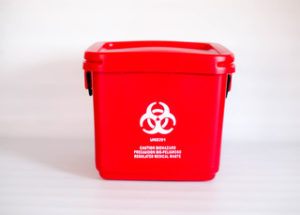Structured Solutions: Streamlining Medical Care Methods with Expert Medical Waste Disposal
Recognizing the Different Types of Garbage Disposal Strategies
In the realm of waste management, the variety of disposal methods offered today is substantial and differed, each method serving an unique function in resolving the obstacle of waste disposal. click here. From recycling techniques that intend to offer brand-new life to materials, to the elaborate procedures of unsafe waste management, the landscape of waste disposal is complicated yet vital for ecological sustainability. Understanding the nuances of these different methods not just clarifies the importance of responsible waste management however additionally motivates us to rethink our strategy towards waste disposal in a rapidly developing world

Recycling Methods
Reusing techniques are important for sustainable waste monitoring methods in both industrial and residential setups. medical waste removal service. By implementing effective recycling techniques, a substantial amount of waste can be drawn away from garbage dumps, preserving natural sources and decreasing the ecological effect of manufacturing processes
In household areas, curbside recycling programs play an essential role in motivating households to different recyclable products from general waste. Products such as paper, plastics, glass, and metals can be sorted and accumulated for processing into brand-new products, minimizing the demand for basic materials and energy-intensive production processes.
Industrial facilities additionally depend on reusing approaches to minimize waste generation and promote a round economic situation. By executing closed-loop systems, companies can recycle products within their production processes, minimizing prices and environmental footprint. medical waste removal service. Furthermore, industrial recycling programs commonly entail partnerships with specialized recycling facilities to make sure that materials are effectively arranged, processed, and rehabilitated right into the supply chain
Composting Strategies

Oxygenated static heap composting includes blending organic waste products in a large stack and routinely turning it to make sure proper oygenation. This strategy is appropriate for smaller-scale procedures and homes.
In-vessel composting entails positioning organic waste in a closed container with controlled conditions for temperature level and oygenation. Windrow composting consists of creating long rows of natural waste and routinely turning them to promote decay - medical waste removal.
Land Fill Disposal
Land fill disposal is a generally made use of technique for handling waste that can not be recycled or composted. Methane gas, a byproduct of decaying natural waste in garbage dumps, is typically gathered and used as a resource of sustainable energy. Efforts to lower reliance on landfills consist of advertising waste reduction, reusing, and checking out alternate waste disposal methods to decrease the environmental footprint linked with standard landfill disposal techniques.

Waste-to-Energy Incineration
Incineration of waste for power generation is a method progressively being taken into consideration as an alternative to standard land fill disposal techniques. Waste-to-energy incineration involves the burning of waste products at high temperatures, usually in specialized centers made to generate electrical power or warm via the process - click here. This technique not only lowers the volume of waste that would or else be predestined for landfills however likewise uses the heat created throughout incineration to develop power
One of the essential benefits of waste-to-energy incineration is its capacity to create electricity while lessening the ecological influence contrasted to conventional landfill disposal techniques. By transforming waste right into power, this strategy helps in lowering greenhouse gas emissions and reliance on fossil fuels for energy generation. Furthermore, waste-to-energy facilities are furnished with sophisticated air contamination control modern technologies to minimize possible toxic wastes launched throughout the burning procedure.
Contaminated Materials Monitoring
.jpg)
Considering the critical relevance of liable waste administration methods, particularly in the realm of ecological sustainability, the emphasis now shifts in the direction of the complex domain of Hazardous Waste Monitoring. Contaminated materials positions significant threats to both human wellness and the atmosphere, necessitating customized handling and disposal methods. Usual examples of hazardous waste consist of chemicals, batteries, pesticides, and digital waste.
Contaminated materials Management involves the recognition, collection, transport, treatment, and disposal of materials deemed damaging or potentially unsafe. This procedure requires adherence to rigorous policies and standards to reduce adverse effects on communities and public wellness. Various approaches are employed in taking care of contaminated materials, consisting of recycling, secure garbage dumps, encapsulation, and chemical treatment.
Proper Unsafe Waste Management is critical for avoiding contamination of dirt, water sources, and air pollution. It is crucial for markets, research laboratories, healthcare facilities, and various other generators of contaminated materials to execute durable monitoring techniques, training programs, and emergency situation feedback plans to guarantee the secure handling and disposal of these products. Failure to handle harmful waste suitably can have far-reaching repercussions, emphasizing the relevance of accountable and attentive techniques in this field.
Conclusion
In verdict, waste disposal methods play an important function in handling and minimizing the influence of waste on the setting. It is crucial for sectors and people to understand the different waste disposal strategies offered and select the most appropriate approach for lasting waste management.
In the world of waste monitoring, the range of disposal techniques readily available today is huge and varied, each method offering a distinct objective in attending to the difficulty of waste disposal. click here. From reusing techniques that aim to offer brand-new life to materials, to the intricate procedures of harmful waste management, the landscape of waste disposal is intricate yet vital for environmental sustainability. Understanding the subtleties of these different techniques not just drops light on the importance of accountable waste helpful site monitoring however also motivates us to reconsider our method in the direction of waste disposal in a quickly evolving globe
Efforts to lower reliance on land fills include advertising waste reduction, reusing, and checking out different waste disposal techniques to minimize the ecological footprint connected with traditional garbage dump disposal practices.
It is crucial for individuals and markets to recognize the different waste disposal methods readily available and select the most ideal method for lasting waste management.